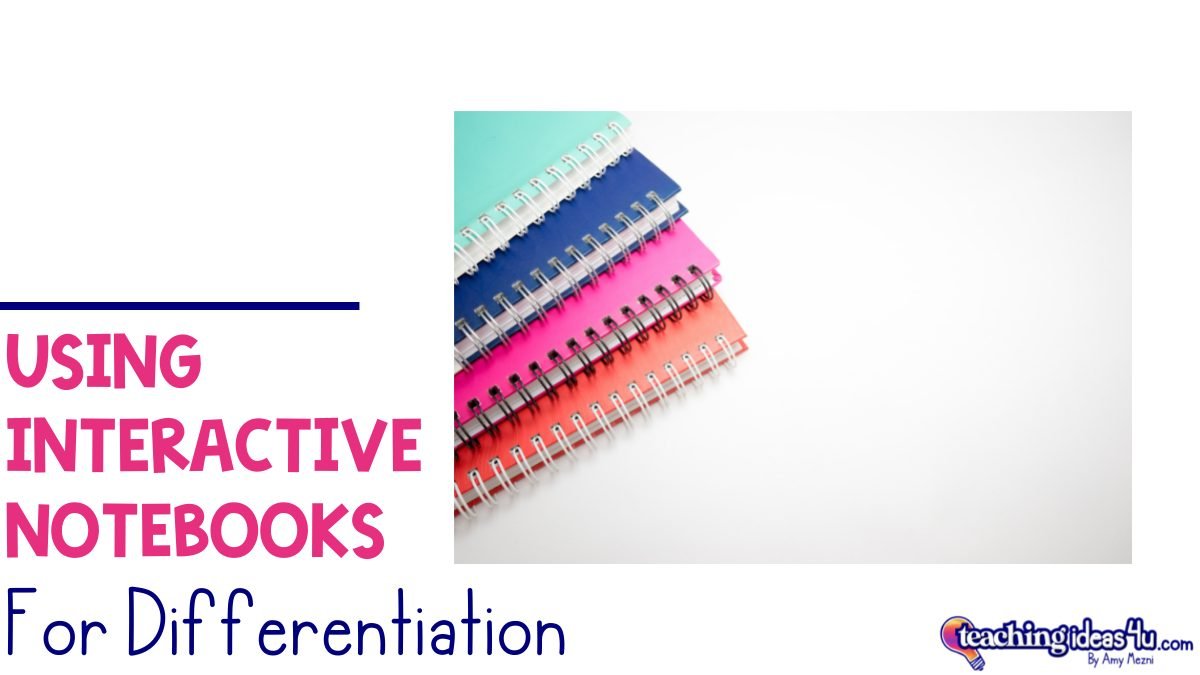How to Use Interactive Notebooks for Differentiation
Interactive notebooks have a bad rap - they take too long to cut and glue, so they aren’t worth so much time. However, for me, the pros outweigh the cons. In my experience, students retained more of what they learned with INBs, and I was better able to meet the needs of my students. It is very easy to differentiate instruction with either printable or digital notebooks.
Let's Talk About Prep
Before we discuss differentiation, let’s talk about how to use INBs effectively. You need to train students to cut and glue in a timely manner. Yes, you need to practice that just like lining up, doing warm-ups, or any other classroom routine.
There are some things you can do to make the prep much faster.
Cut and glue at least a week’s worth of organizers at once. It takes a lot more time to get the materials in and out every day. I would make my notebook and show students how to put each organizer in their book.
Use the practice time to identify which students cannot cut - many students have weak fine motor skills today (that is a discussion for another post.) Also, students may have vision issues that impact how easily they can cut. After I identified these students, I either helped them cut out their pieces or cut a set for them. I also identified my crafty kids and made them helpers who went around and helped other kids get finished. (Guess what? Doing that is a differentiation of the learning environment.)
As you practice, monitor how long it takes. Generally, I found it took students much longer than I thought in the beginning. As we practiced and students learned the expectation, it went much faster. I also took note of the time needed and made the amount of time I gave them (which I would change if I saw the class needed more or less time, but it was a good ballpark.)
Make the prep work your Warm-Up or Morning Work. That way, you are using up time that you wouldn’t necessarily use for instruction.
Ways to Differentiate With Interactive Notebooks
As I discussed in a previous post, there are four lesson elements that teachers can differentiate: content, process, product, and affect/learning environment. Interactive notebooks can be used to differentiate any of them. Here are some easy ways you can differentiate with INBs:
Digital Option
For students who have difficulty copying notes or with fine motor schools, teachers can provide a digital option of the printable notebook.
Graphic Organizers
Using graphic organizers is part of the learning process. I have seen photos of notebooks that were made with blank organizers - teachers had students write the topics on them.
Instead of that, teachers can print the organizers with topics and guiding questions. These questions provide reading support and help students know what is important in the reading. (Many students struggle to identify which information is important to write in their notes.)
Cloze Notes
For a variety of reasons, some students struggle with note-taking. Yes, we want students to be independent, but that takes practice and some students have learning issues that interfere with taking notes.
An alternative is to create fill-in-the-blank organizers. Teachers can print blank organizers for some students and only give the Cloze notes to those who need more support. (For younger students, I have given the Cloze notes to everyone.)
Vary Activities
I love being able to add a wide variety of activities to a notebook. Sometimes they are foldable for straight notes, but I have also used maps, timelines, short responses, and sorting activities. INBs are highly adaptable so you can include a variety of learning modalities.
Teacher Notebook
I always created a teacher notebook with students. That way, students who missed notes either from being absent or because they got behind could come and borrow my notes. Students were less anxious about taking notes because they knew they could get what they needed later.
Glue Everything
Have you ever had a “perfect” system for class notes, only to have a few students lose random papers? Yes, me, too. There are always some students who struggle with organization.
I began having students glue everything in their notebooks, especially in upper elementary. We didn’t necessarily cut papers, but if we had a paper I felt they might need as a reference, we folded it and glued one side to a page in the notebook.
It still didn’t completely solve the lost paper issue, but it helped tremendously.
I am sure there are other ways you could differentiate with interactive notebooks, but these are all ways that I did. I found my students were proud of their notebooks - especially some of my less-engaged kids. They liked seeing how much they achieved, but I also made the notebooks student-friendly and they felt successful.
When students feel successful, they are more willing to attempt classwork. I found interactive notebooks increased my students’ participation and achievement.
To learn more about differentiation, check out this blog post.
Interactive Notebooks
If you want to purchase premade INBS, I have many notebooks, both printable and digital, in my TPT store. Some of the notebooks are for social studies, while others are for reading strategies and Greek and Latin Roots.
In my store, use the categories on the left to navigate to the topic you need. Can’t find what you are looking for? Just drop me an email.

